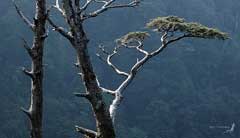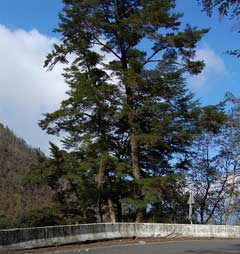 |
|
flickr.com/photos/bettaman |
 |
| flickr.com/people/7484274@N06 |
Translate this page:
Summary
Physical Characteristics

 Tsuga chinensis is an evergreen Tree growing to 45 m (147ft 8in) at a slow rate.
Tsuga chinensis is an evergreen Tree growing to 45 m (147ft 8in) at a slow rate.
See above for USDA hardiness. It is hardy to UK zone 6 and is not frost tender. It is in leaf all year, in flower in April, and the seeds ripen from October to November. The species is monoecious (individual flowers are either male or female, but both sexes can be found on the same plant) and is pollinated by Wind.
Suitable for: light (sandy), medium (loamy) and heavy (clay) soils and prefers well-drained soil. Suitable pH: mildly acid, neutral and basic (mildly alkaline) soils and can grow in very acid soils.
It can grow in full shade (deep woodland) semi-shade (light woodland) or no shade. It prefers moist soil.
UK Hardiness Map
US Hardiness Map
Synonyms
Abies chinensis.
Plant Habitats
Woodland Garden Canopy; Hedge;
Edible Uses
Edible Parts: Inner bark Shoots
Edible Uses: Tea
Inner bark - raw or dried, ground into a powder and then used as a thickening in soups etc or mixed with cereals when making bread[2, 46, 161]. A herbal tea is made from the young shoot tips[2, 62, 95, 159, 183]. These tips are also an ingredient of 'spruce beer'[183].
References More on Edible Uses
Medicinal Uses
Plants For A Future can not take any responsibility for any adverse effects from the use of plants. Always seek advice from a professional before using a plant medicinally.
Astringent Diaphoretic Diuretic
The bark is astringent, diaphoretic and diuretic[21]. A tea made from the inner bark or twigs is helpful in the treatment of kidney or bladder problems, and also makes a good enema for treating diarrhoea[21]. It can also be used as a gargle or mouthwash for mouth and throat problems or externally to wash sores and ulcers[21]. The powdered bark can be put into shoes for tender or sweaty feet or for foot odour[21].
References More on Medicinal Uses
The Bookshop: Edible Plant Books
Our Latest books on Perennial Plants For Food Forests and Permaculture Gardens in paperback or digital formats.

Edible Tropical Plants
Food Forest Plants for Hotter Conditions: 250+ Plants For Tropical Food Forests & Permaculture Gardens.
More

Edible Temperate Plants
Plants for Your Food Forest: 500 Plants for Temperate Food Forests & Permaculture Gardens.
More

More Books
PFAF have eight books available in paperback and digital formats. Browse the shop for more information.
Shop Now
Other Uses
Dye Hedge Hedge Resin Tannin Wood
Apart from the report about the use of the wood, all the other uses listed below are based on the uses that T. canadensis is put to and a note in [46] that this species has similar uses. Yields a resin similar to Abies balsamea, it is gathered by incisions in the trunk or by boiling the wood[46, 61, 64]. The bark contains 8 - 14% tannin[46, 171]. The inner bark is used according to one report[82]. A brown dye is obtained from the bark[21, 46]. A pitch (called hemlock pitch), is obtained by distillation of the young branches[46]. Tolerant of light trimming, plants can be grown as a hedge[81]. This species does not make a good hedge in Britain[200]. Wood - soft, durable. Used for shingles[82]. The timber is used for construction, aircraft, furniture, and in mines[266].
Special Uses
Hedge Hedge
References More on Other Uses
Cultivation details
An easily grown plant, it thrives best when growing in a deep well-drained soil in the western parts of Britain where it appreciates the higher rainfall[11]. However, it succeeds in most soils and positions, being especially good on acidic sandy soils[81] but also tolerating some lime[11] so long as there is plenty of humus in the soil[208]. Plants are very shade tolerant when young, but need more sunlight as they grow older[81, 200]. Plants are thin and poor when grown in dry or exposed places[200]. A very slow growing tree in most of Britain but probably faster in the far west and in Ireland[185]. Plants require hot humid summers and do not usually thrive in Britain[200]. Plants are very liable to injury by late frosts[1], they are often shrubby in cultivation[200]. Plants in this genus are notably resistant to honey fungus[200].
References Carbon Farming Information and Carbon Sequestration Information
Temperature Converter
Type a value in the Celsius field to convert the value to Fahrenheit:
Fahrenheit:
The PFAF Bookshop
Plants For A Future have a number of books available in paperback and digital form. Book titles include Edible Plants, Edible Perennials, Edible Trees,Edible Shrubs, Woodland Gardening, and Temperate Food Forest Plants. Our new book is Food Forest Plants For Hotter Conditions (Tropical and Sub-Tropical).
Shop Now
Plant Propagation
Seed - it germinates better if given a short cold stratification[80, 113] and so is best sown in a cold frame in autumn to late winter. It can also be sown in early spring, though it might not germinate until after the next winter. If there is sufficient seed, an outdoor sowing can be made in spring[78]. Pot-grown seedlings are best potted up into individual pots once they are large enough to handle - grow them on in a cold frame and plant them out in early summer of the following year. Trees transplant well when they are up to 80cm tall, but they are best put in their final positions when they are about 30 - 45 cm or less tall, this is usually when they are about 5 - 8 years old[200]. Larger trees will check badly and hardly put on any growth for several years. This also badly affects root development and wind resistance[200].
Other Names
If available other names are mentioned here
Native Plant Search
Search over 900 plants ideal for food forests and permaculture gardens. Filter to search native plants to your area. The plants selected are the plants in our book 'Plants For Your Food Forest: 500 Plants for Temperate Food Forests and Permaculture Gardens, as well as plants chosen for our forthcoming related books for Tropical/Hot Wet Climates and Mediterranean/Hot Dry Climates. Native Plant Search
Found In
Countries where the plant has been found are listed here if the information is available
Weed Potential
Right plant wrong place. We are currently updating this section.
Please note that a plant may be invasive in one area but may not in your area so it’s worth checking.
Conservation Status
IUCN Red List of Threatened Plants Status :

Growth: S = slow M = medium F = fast. Soil: L = light (sandy) M = medium H = heavy (clay). pH: A = acid N = neutral B = basic (alkaline). Shade: F = full shade S = semi-shade N = no shade. Moisture: D = dry M = Moist We = wet Wa = water.

Expert comment
Author
(Franch.)E.Pritz.
Botanical References
11200266
Links / References
For a list of references used on this page please go here
Readers comment
© 2010, Plants For A Future. Plants For A Future is a charitable company limited by guarantee, registered in England and Wales. Charity No. 1057719, Company No. 3204567.